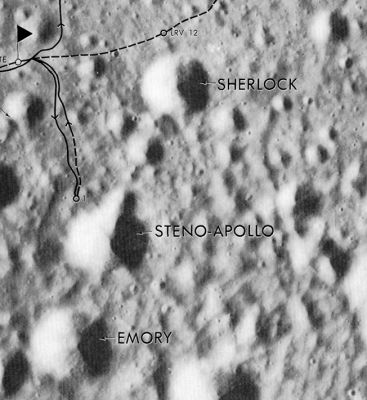Difference between revisions of "Emory"
(Created page with "<div id="content_view" class="wiki" style="display: block"> =Emory (Apollo 17 site craterlet name)= {| class="wiki_table" | Lat: 20.1°N, Long: 30.8°E, Diam: 1 km, Depth:...") |
(No difference)
|
Revision as of 19:49, 10 April 2018
Contents
Emory (Apollo 17 site craterlet name)
|
Lat: 20.1°N, Long: 30.8°E, Diam: 1 km, Depth: km, [/R%C3%BCkl%2025 Rükl: 25] |
Table of Contents
[#Emory (Apollo 17 site craterlet name) Emory (Apollo 17 site craterlet name)]
[#Emory (Apollo 17 site craterlet name)-Images Images]
[#Emory (Apollo 17 site craterlet name)-Maps Maps]
[#Emory (Apollo 17 site craterlet name)-Description Description]
[#Emory (Apollo 17 site craterlet name)-Description: Wikipedia Description: Wikipedia]
[#Emory (Apollo 17 site craterlet name)-Additional Information Additional Information]
[#Emory (Apollo 17 site craterlet name)-Nomenclature Nomenclature]
[#Emory (Apollo 17 site craterlet name)-LPOD Articles LPOD Articles]
[#Emory (Apollo 17 site craterlet name)-Bibliography Bibliography]

Apollo 17 Site Traverses Chart
Images
LPOD Photo Gallery Lunar Orbiter Images Apollo Images
Maps
([/LAC%20zone LAC zone] 43D1) LAC map Geologic map LTO map
IAU page
Description
The [/Landing%20Site%20Name Landing Site Name] "Emory" is plotted on Topophotomap 43D1/S1 and Site Traverses chart 43D1S2.
- Emory (crater) - "William H. Emory was one of the most capable members of the United States Army Corps of Topographical Engineers who, in the quarter century prior to the American Civil War, systematically explored the American West. This group of military officers and explorers had specialized training in the physical sciences and engineering, and held many close parallels to the Astronauts and Cosmonauts of today. Following in the footsteps of Lewis and Clark and the mountain men, they provided the basic information required to open up the West for travel and eventual settlement." The crew of Apollo 17 planned to stop at Emory during the first EVA but, because they ran short of time, made a geology stop near Steno, a crater much closer to the LM (source: APOLLO LUNAR SURFACE JOURNAL, Eric M. Jones).
Description: Wikipedia
Emory (correct link)
Additional Information
- Gene Cernan's (possible) observation of Emory from Apollo 17's Station 1 near Steno-Apollo crater, see page 260 in David M. Harland's Exploring the Moon (1999).- DannyCaes DannyCaes May 4, 2014
Nomenclature
- Astronaut-named feature, [/Apollo%2017%20site Apollo 17 site], approved in [/IAU%20Transactions%20XVIB IAU Transactions XVIB] (1976).
- The name honors William H. Emory (1811–1887), an Army officer involved in the mapping of the American Southwest. The astronauts regarded his role and training as analogous to their own in exploring space.
- A small crater southwest of Emory seems to have been called Mitchell. Another small crater southeast of Emory seems to have been called Towers. A crater about the same size of Emory (east of Emory itself) seems to have been called Faust. (source: APOLLO 17 Preliminary Science Report).- DannyCaes DannyCaes May 4, 2014
LPOD Articles
Bibliography
Harland, David M. EXPLORING THE MOON, the Apollo expeditions.
Jones, Eric M. APOLLO LUNAR SURFACE JOURNAL (ALSJ).
This page has been edited 1 times. The last modification was made by - tychocrater tychocrater on Jun 13, 2009 3:24 pm - afx3u2